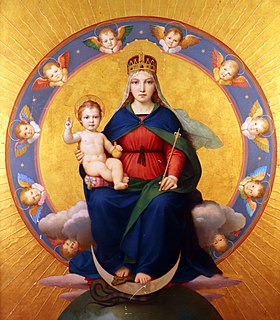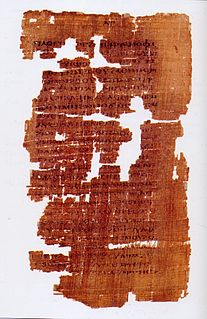Related Research Articles

The book of Revelation is the final book of the New Testament. Its title is derived from the first word of the Koine Greek text: apokalypsis, meaning "unveiling" or "revelation". The Book of Revelation is the only apocalyptic book in the New Testament canon. It occupies a central place in Christian eschatology.

Apocalypse is a literary genre in which a supernatural being reveals cosmic mysteries or the future to a human intermediary. The means of mediation include dreams, visions and heavenly journeys, and they typically feature symbolic imagery drawn from the Hebrew Bible, cosmological and (pessimistic) historical surveys, the division of time into periods, esoteric numerology, and claims of ecstasy and inspiration. Almost all are written under pseudonyms, claiming as author a venerated hero from previous centuries, as with Book of Daniel, composed during the 2nd century BCE but bearing the name of the legendary Daniel.

The Gospel of Thomas is an extra-canonical sayings gospel. It was discovered near Nag Hammadi, Egypt, in December 1945 among a group of books known as the Nag Hammadi library. Scholars speculate that the works were buried in response to a letter from Bishop Athanasius declaring a strict canon of Christian scripture. Scholars have proposed dates of composition as early as AD 60 and as late as AD 250. Since its discovery, many scholars have seen it as evidence in support of the existence of a "Q source", which might have been very similar in its form as a collection of sayings of Jesus without any accounts of his deeds or his life and death, referred to as a "sayings gospel".

The Messiah in Judaism is a savior and liberator figure in Jewish eschatology, who is believed to be the future redeemer of the Jewish people. The concept of messianism originated in Judaism, and in the Hebrew Bible a messiah is a king or High Priest traditionally anointed with holy anointing oil. However, messiahs were not exclusively Jewish, as the Hebrew Bible refers to Cyrus the Great, king of Persia, as a messiah for his decree to rebuild the Jerusalem Temple.
The Nag Hammadi library is a collection of early Christian and Gnostic texts discovered near the Upper Egyptian town of Nag Hammadi in 1945.
Apocalyptic literature is a genre of prophetical writing that developed in post-Exilic Jewish culture and was popular among millennialist early Christians. Apocalypse is a Greek word meaning "revelation", "an unveiling or unfolding of things not previously known and which could not be known apart from the unveiling".

The Apocalypse of Peter is an early Christian text of the 2nd century and an example of apocalyptic literature with Hellenistic overtones. It is not included in the standard canon of the New Testament, but is mentioned in the Muratorian fragment, the oldest surviving list of New Testament books, which also states some among authorities would not have it read in church. The text is extant in two incomplete versions of a lost Greek original, a later Greek version and an Ethiopic version, which diverge considerably.

The New Testament apocrypha are a number of writings by early Christians that give accounts of Jesus and his teachings, the nature of God, or the teachings of his apostles and of their lives. Some of these writings have been cited as scripture by early Christians, but since the fifth century a widespread consensus has emerged limiting the New Testament to the 27 books of the modern canon. Roman Catholic, Eastern Orthodox, and Protestant churches generally do not view these New Testament apocrypha as part of the Bible.
The Sethians were one of the main currents of Gnosticism during the 2nd and 3rd century CE, along with Valentinianism and Basilideanism. According to John D. Turner, it originated in the 2nd-century CE as a fusion of two distinct Hellenistic Judaic philosophies and was influenced by Christianity and Middle Platonism. However, the exact origin of Sethianism is not properly understood.

The Epistle of the Apostles is a work of New Testament apocrypha. Despite its name, it is more a gospel or an apocalypse than an epistle. The work takes the form of an open letter purportedly from the remaining eleven apostles describing key events of the life of Jesus, followed by a dialogue between the resurrected Jesus and the apostles where Jesus reveals apocalyptic secrets of reality and the future. It is 51 chapters long. The epistle was likely written in the 2nd century CE in Koine Greek, but was lost for many centuries. A partial Coptic language manuscript was discovered in 1895, a more complete Ethiopic language manuscript was published in 1913, and a full Coptic-Ethiopic-German edition was published in 1919.
The Apocalypse of Zephaniah is a 1st-century pseudepigraphic Jewish text attributed to the Biblical Zephaniah and so associated with the Old Testament, but not regarded as scripture by Jews or any Christian group. It was rediscovered and published at the end of the 19th century. The canonical Book of Zephaniah has much mystical and apocalyptic imagery, and this apocalyptic-style text deals with a similar subject.
In Jewish eschatology Mashiach ben Yoseph or Messiah ben Joseph, also known as Mashiach bar/ben Ephraim, is a Jewish messiah from the tribe of Ephraim and a descendant of Joseph. The figure's origins are much debated. Some regard it as a rabbinic invention, but others defend the view that its origins are in the Torah.

The Apocalypse of Elijah is an early Christian work written in the Coptic language commonly held to be a documentation of the oral presentation of multiple original and classical manuscripts. Presented in part as the direct word of the Hebrew God, Yahweh, to the biblical prophet Elijah, from where its name is derived, the text includes a short commentary on some early Christian fasting and prayer disciplines, a prophetic message about the kingdoms of Assyria and Egypt, and accounts of the presentation of the antichrist, his encounters with Elijah and Enoch, and his ultimate demise.
Sefer Zerubavel, also called the Book of Zerubbabel or the Apocalypse of Zerubbabel, is a medieval Hebrew apocalypse written at the beginning of the 7th century CE in the style of biblical visions placed into the mouth of Zerubbabel, the last descendant of the Davidic line to take a prominent part in Israel's history, who laid the foundation of the Second Temple in the 6th century BCE. The enigmatic postexilic biblical leader receives a revelatory vision outlining personalities and events associated with the restoration of Israel, the End of Days, and the establishment of the Third Temple.
Chapters 10, 11, and 12 in the Book of Daniel make up Daniel's final vision, describing a series of conflicts between the unnamed "King of the North" and "King of the South" leading to the "time of the end", when Israel will be vindicated and the dead raised, some to everlasting life and some to shame and everlasting contempt.

Christianity in the 1st century covers the formative history of Christianity from the start of the ministry of Jesus to the death of the last of the Twelve Apostles and is thus also known as the Apostolic Age. Early Christianity developed out of the eschatological ministry of Jesus. Subsequent to Jesus' death, his earliest followers formed an apocalyptic messianic Jewish sect during the late Second Temple period of the 1st century. Initially believing that Jesus' resurrection was the start of the end time, their beliefs soon changed in the expected Second Coming of Jesus and the start of God's Kingdom at a later point in time.

The Prayer of Joseph is a pseudepigraphic writing of the Old Testament. It was composed either in Aramaic or in Greek in the 1st century AD. The text is almost lost and only a few fragments have survived in ancient quotations concerning the Biblical patriarch Jacob. The Prayer of Joseph narrates that Jacob was the incarnation of the angel Israel who competed with Uriel over their rank in heaven.
Nehemiah ben Hushiel is thought to be a historical figure and leader of the Jewish revolt against Heraclius. He is noted in Jewish and Byzantine sources. Nehemiah ben Hushiel is best known as a figure who appears in many medieval Jewish apocalyptic writings; in these writings he is cast as the Messiah ben Joseph.
Menahem ben Ammiel, or ben Amiel, is a character in apocalyptic Jewish texts, the future Messiah ben David of the Sefer Zerubbabel. He fights against Armilus, the Jewish apocalyptic counterpart of the Christian Book of Revelation's Antichrist.
The Apocalypse of Shenute is a short Coptic apocalyptic text which purports to be a prophecy of Shenute from Christ about the eschaton. The Coptic Apocalypse of Elijah greatly influenced the text. It is the oldest miaphysite Coptic apocalypse to survive from the Islamic period, a rare contemporary witness to Coptic–Muslim relations in the earliest period, one of the earliest miaphysite Coptic sources to mention the Islamic rejection of the crucifixion of Christ, and a response to the Islamic conversion of Copts.
References
- ↑ Buttenwieser, Moses (1901). "Outline of the Neo-Hebraic Apocalyptic Literature." Cincinnati: Jennings & Pye. pp. 30.
- ↑ Collins, John (2016). "The Apocalyptic Imagination" Grand Rapids: Wm. B. Eerdmans Publishing Co. pp. 5.
- ↑ Reeves, John C. "Sefer Elijah". www.charlotte.edu. UNC Charlotte.
- ↑ Wintermute, O.S. "Apocalypse of Elijah: A New Translation and Introduction." The Old Testament Pseudepigrapha: Apocalyptic Literature and Testaments, edited by James H. Charlesworth, Doubleday & Company (1983). pp. 721-753. ISBN 0-385-09630-5.
- ↑ Frankfurter, David (1993). "Elijah in Upper Egypt: The Apocalypse of Elijah and Early Egyptian Christianity" (Studies in Antiquity and Christianity). Minneapolis: Fortress Press. pp. 50. ISBN 0-8006-3106-4.
This article has not been added to any content categories . Please help out by adding categories to it so that it can be listed with similar articles, in addition to a stub category. (April 2022) |